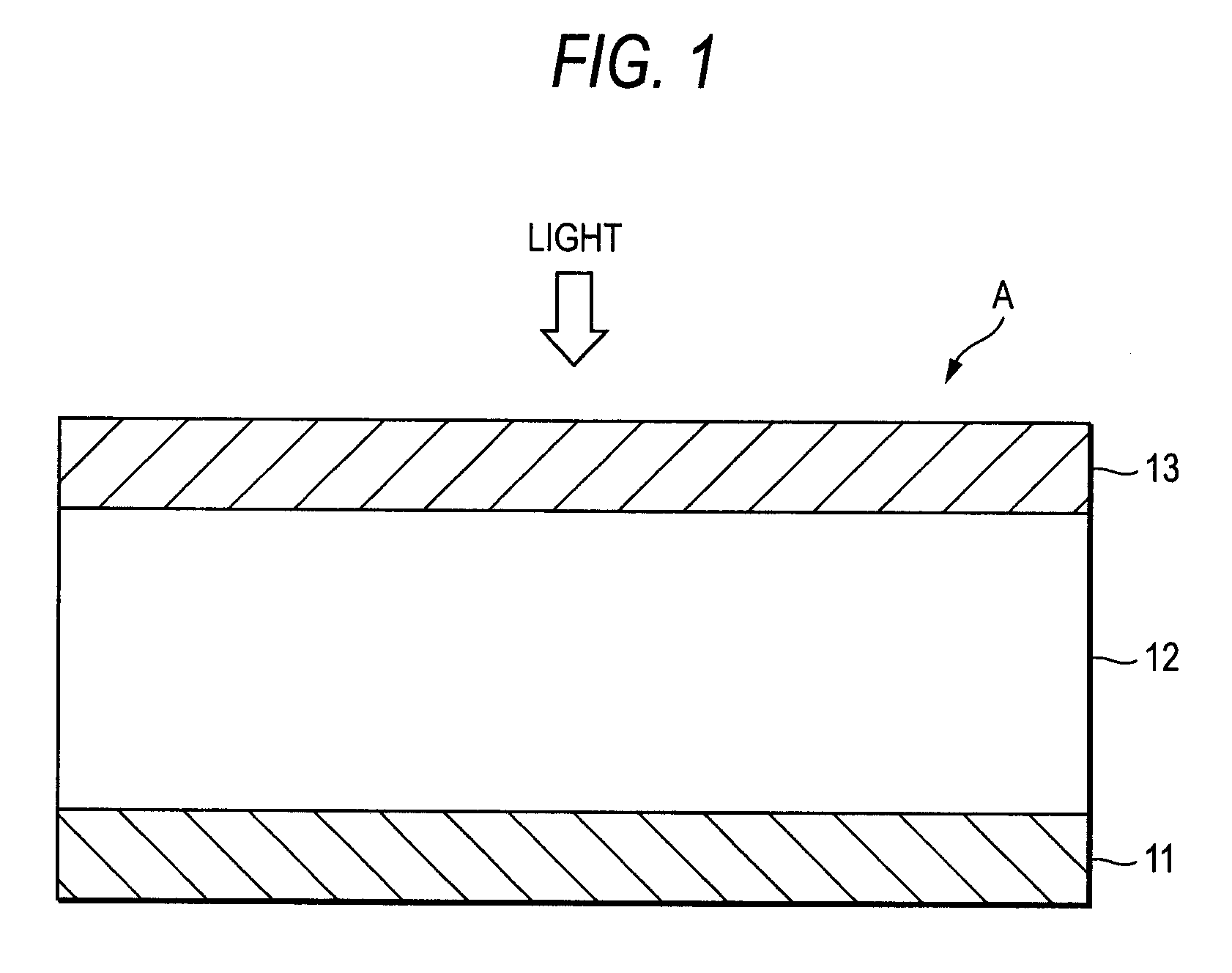Photoelectric conversion element and solid-state imaging device
a technology of conversion element and photoelectric element, which is applied in the direction of thermoelectric devices, group 3/13 element organic compounds, methine/polymethine dyes, etc., can solve the problems of large device or apparatus size, poor light utilization efficiency, and increased cost, and achieve high photoelectric conversion efficiency, low noise, and good vapor deposition property
- Summary
- Abstract
- Description
- Claims
- Application Information
AI Technical Summary
Benefits of technology
Problems solved by technology
Method used
Image
Examples
first embodiment
[0073]FIG. 1 is a cross-sectional schematic view roughly showing the construction of the photoelectric conversion element in the first embodiment of the present invention.
[0074]The photoelectric conversion element shown in FIG. 1 comprises at least a photoelectric conversion part A containing a lower electrode 11, an upper electrode 13 facing the lower electrode 11, and a photoelectric conversion film 12 provided between the lower electrode 11 and the upper electrode 13. The photoelectric conversion element shown in FIG. 1 is used by making light incident from the upper side of the upper electrode 13.
[0075]The upper electrode 13 is a transparent electrode composed of an electrically conductive material transparent to light (visible light and infrared light) in the combined range of a visible region and an infrared region (the range at a wavelength of 400 nm or more). The expression “transparent to light at a certain wavelength” as used in the present invention means that 70% or more...
second embodiment
[0114]FIGS. 2A to 2D are cross-sectional schematic views roughly showing the construction of the photoelectric conversion element in the second embodiment of the present invention.
[0115]The photoelectric conversion element shown in FIG. 2A comprises a semiconductor substrate K such as silicon, a visible light photoelectric conversion part B stacked on the upper side of the semiconductor substrate K, and the photoelectric conversion part A shown in FIG. 1 stacked on the upper side of the visible light photoelectric conversion part B.
[0116]The visible light photoelectric conversion part B has almost the same construction as the photoelectric conversion part A and as for the organic photoelectric conversion material constituting the photoelectric conversion film 12 of the photoelectric conversion part A, a material having an absorption peak in the visible region of an absorption spectrum in the combined range of a visible region and an infrared region (the range at a wavelength of 400 ...
third embodiment
[0166]In this embodiment, a construction of realizing a solid-state imaging device by using the photoelectric conversion element having the construction shown in FIG. 2B is described.
[0167]FIG. 4 is a partial surface schematic view of the imaging device for explaining the embodiment of the present invention, and FIG. 5 is a cross-sectional schematic view cut along the A-A line of the imaging device shown in FIG. 4. In FIG. 4, illustration of a microlens 14 is omitted. Also, in FIG. 5, the same constituents as those in FIG. 1 are indicated by the same numerical references.
[0168]A p-well layer 2 is formed on an n-type silicon substrate 1. In the following, the n-type silicon substrate 1 and the p-well layer 2 are collectively referred to as a semiconductor substrate. In the row direction and the column direction crossing the row direction at right angles on the same plane above the semiconductor substrate, three kinds of color filters, that is, a color filter 13r mainly transmitting R...
PUM
| Property | Measurement | Unit |
|---|---|---|
| transmittance | aaaaa | aaaaa |
| transmittance | aaaaa | aaaaa |
| decomposition temperature | aaaaa | aaaaa |
Abstract
Description
Claims
Application Information
 Login to View More
Login to View More - R&D
- Intellectual Property
- Life Sciences
- Materials
- Tech Scout
- Unparalleled Data Quality
- Higher Quality Content
- 60% Fewer Hallucinations
Browse by: Latest US Patents, China's latest patents, Technical Efficacy Thesaurus, Application Domain, Technology Topic, Popular Technical Reports.
© 2025 PatSnap. All rights reserved.Legal|Privacy policy|Modern Slavery Act Transparency Statement|Sitemap|About US| Contact US: help@patsnap.com



